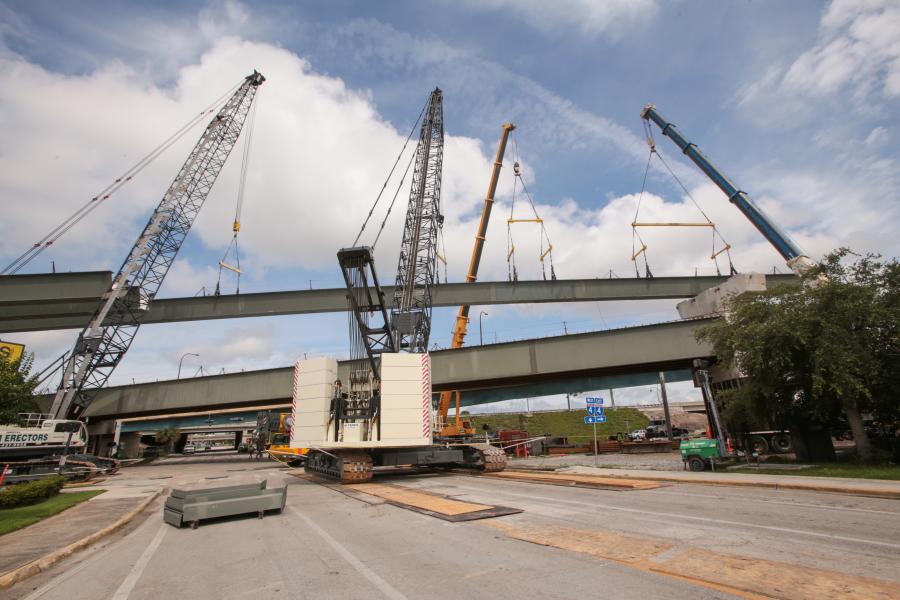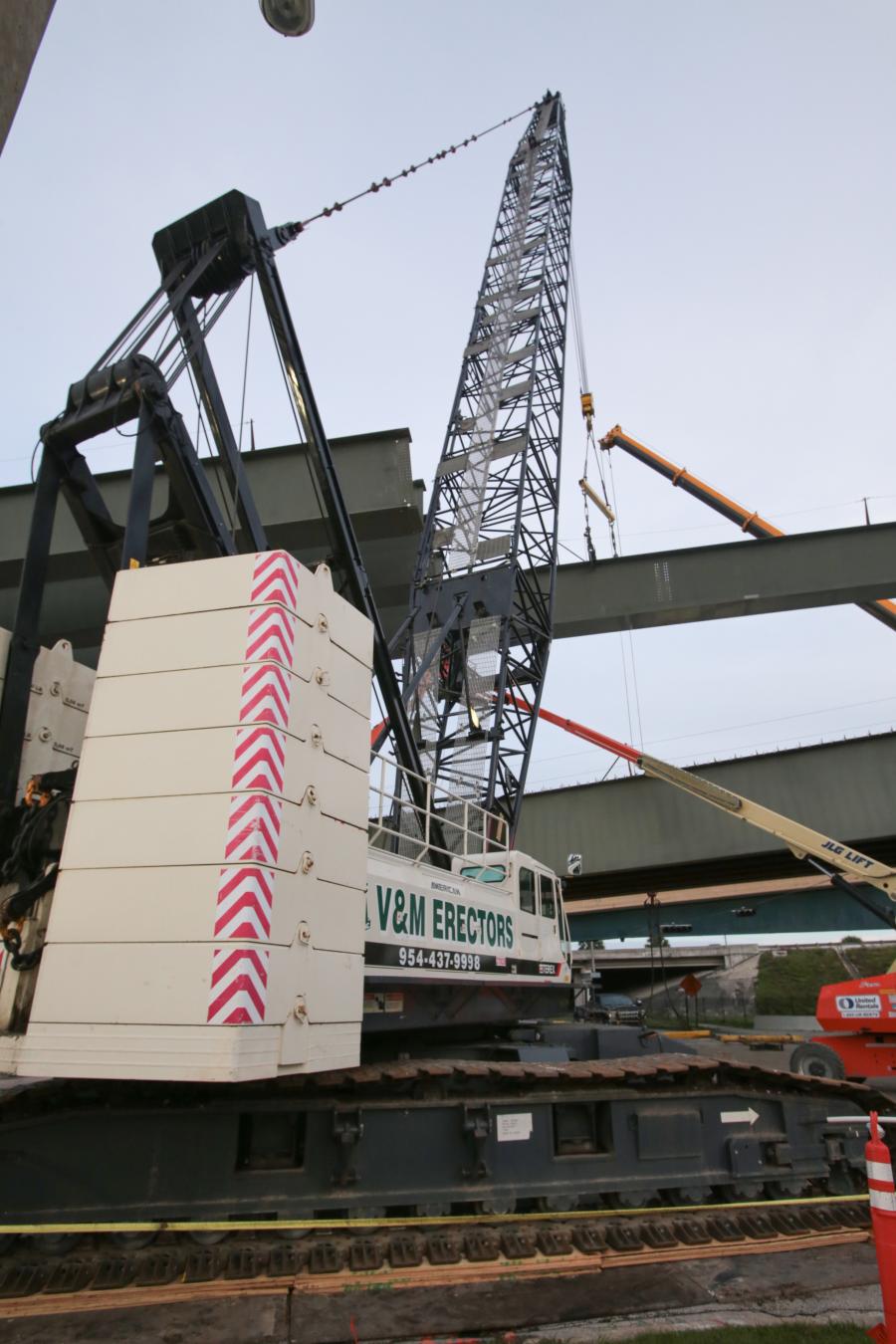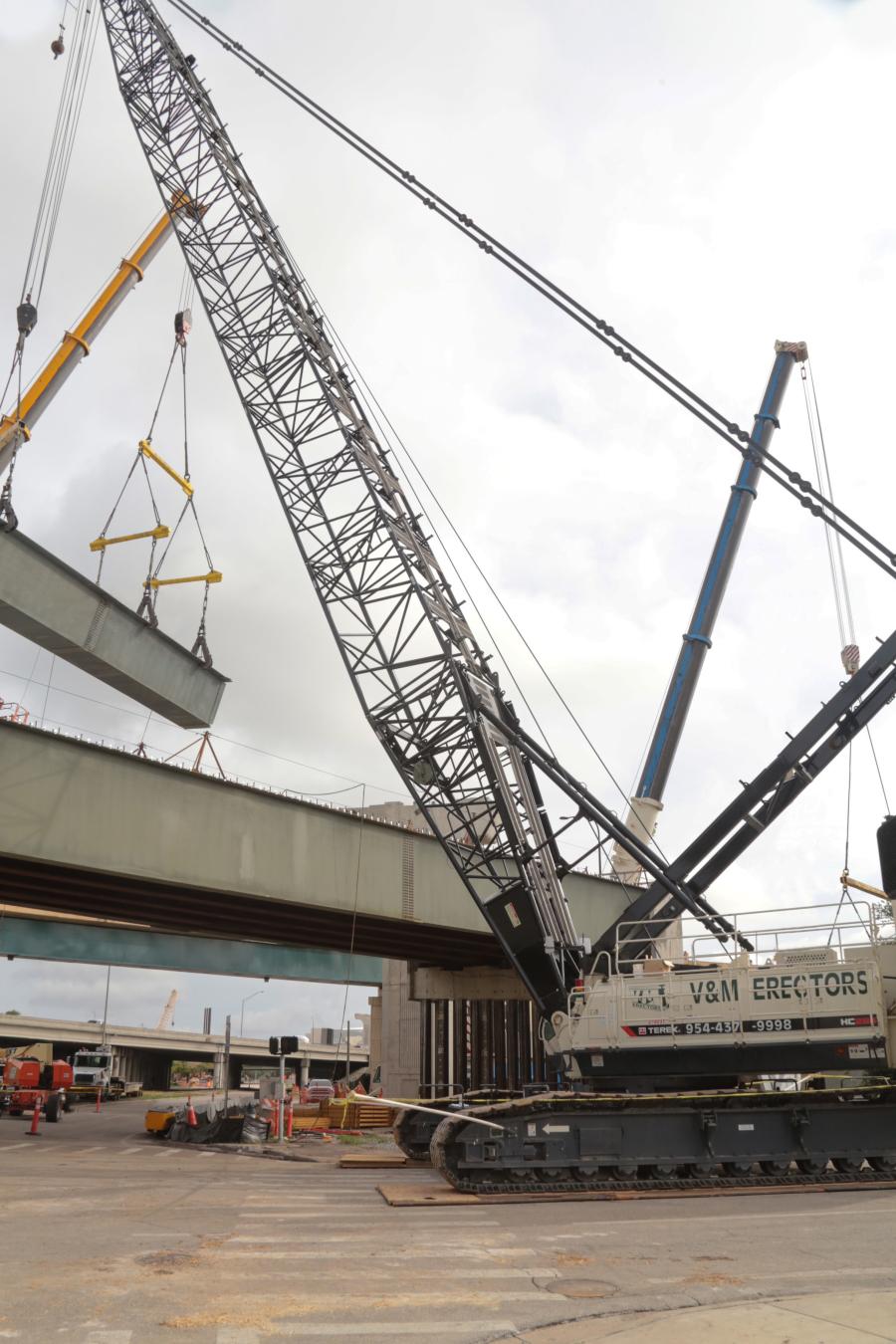
Tue February 12, 2019
Terex Cranes
At 21 miles long and $2.3 billion, Orlando's massive I-4 Ultimate is the largest infrastructure project in the Florida Department of Transportation's (FDOT) history. By the time the last yard of concrete is placed in 2021, the project will consume 6.7 million cu. yds. (4.8 million cu m) of fill material, require 1.74 million linear ft. (530,350 m) of bridge, overpass, ramp, and structure piles, have 2.25 million sq. ft. (209,030 sq m) of bridge deck paved and use 591,250 cu. yds. (16,740 cu m) of concrete.
Divided into four phases, the project will require monumental bridge work to improve traffic flow through the heart of central Florida. Thirteen existing structures will be widened, 53 new bridges added and 74 bridges replaced. Area 2, currently under construction, dissects downtown Orlando from Highway 50 at the northern edge to the Highway 423/I-4 interchange at its southernmost part.
"We will be adding or reconstructing 40 structures in this area," said Vern Nix, owner of V&M Erectors Inc., of Pembroke Pines, Fla. "We need to place 50 million pounds of steel for this phase of the contract."
V&M is a critical fixture in the southeastern U.S. bridge-building market. Nix offers the industry more than 50 years of structural steel and falsework construction experience.
"Vern is very hands-on, and V&M is one of the most sought-after structural steel contractors in the bridge sector," said Bob Renegar, president of Renegar-Driggers, Florida's authorized Terex Cranes distributor.

In addition to being the largest infrastructure project in Florida, the I-4 Ultimate project ranks among the most complex and congested sites for bridge building. Area 2 comprises of multiple high-level flyover ramps, which makes accessing the site challenging.
Initially, V&M rented cranes to complete bridge work. When the opportunity presented several years ago, the company purchased a 230-ton (208-t) Terex HC 230 lattice boom crawler crane. The efficiency and flexibility gained by owning a crane versus renting fueled V&M's growth. A year later, the company purchased a new 275-ton (250-t) Terex HC 275 crane.
With the company's reputation for delivering quality projects spreading and the complexity and size of projects increasing, V&M added another high-capacity Terex crane in 2018. It invested in a larger, Terex HC 285 crawler crane, offering a 285-ton (258-t) capacity and maximum 300-ft. (91.4-m) main boom.
Complex and Congested
In addition to being the largest infrastructure project in Florida, the I-4 Ultimate project ranks among the most complex and congested sites for bridge building. Area 2 comprises of multiple high-level flyover ramps, which makes accessing the site challenging.
"It's a difficult project to deal with the traffic flow and existing structures, and it is very congested," said Nix. "The erection scheme includes tight coordinates to place the girders into location. This requires us to set-up, tear-down and move the cranes a lot."
Bridge length in Area 2 averages 2,000 to 3,000 ft. (609.6 to 914.4 m). Rather than working at night to place girders, V&M and the Florida DOT are using 40- to 56-hour road closure times to improve bridge construction efficiency and limit impact on traffic.

Divided into four phases, the project will require monumental bridge work to improve traffic flow through the heart of central Florida. Thirteen existing structures will be widened, 53 new bridges added and 74 bridges replaced.
"We install an average of 9 to 15 girders over an existing road, so it makes it much more efficient for all trades if we close the road over a weekend versus working on it over 10-plus nights," said Nix.
The work schedule requires V&M to quickly move from bridge to bridge, and each bridge consists of one to five units. Within each bridge unit, workers must move the cranes three to four times. Therefore, using a crawler crane that is easy to assemble, disassemble and move around the site is critical for the schedule.
This is why V&M chose to use all three of its Terex HC crawler cranes on the project. The cranes' designs make them conducive for quickly moving from site to site and within the construction site.
"These cranes are built for the needs of road and bridge contractors. The carbodies of the HC 230, HC 275 and HC 285 cranes have heights and widths no greater than 12 feet, so they are easily transported to the site on a lowboy trailer," said Renegar.
"We move the cranes on our own and have them rigged with counterweight and boom in 1 to 1.5 days," Nix added.
Once on site, the Terex HC series cranes' hydraulic counterweight removal system simplifies and reduces plate installation and removal time. The HC 230 features the standard Couterweight Plus package that provides an additional 54,000 lb. (24,494 kg) counterweight for the machine to offer increased lift capacities.
"We are using full counterweight on the crawler cranes and have to work at up to 100-foot radii at times," said Nix.
A Helping Hoist
Throughout Area 2, V&M will equip its three HC cranes with boom configurations ranging from 140 to 200 ft. (42.7 to 61 m) and work at radii where the lift chart offers capacities from 150,000 to 200,000 lb. (68,039 to to 90,718 kg). Workers preassemble two sections of girder on the ground before hoisting up to 200-ft-long (61-m) sections that weigh up to 200,000 lb.
"The Terex HC cranes offer a strong lift chart," said Nix.
For maximum capacity, the cranes are rigged in their full counterweight configurations. Additionally, a luffing jib is kept on site to assist lifting the preassembled girders over structures.
"In this congested area, we cannot boom down enough, so we need the jib at times," said Nix.
There are times during the installation process, such as on the recently completed bridge number 225, when the cranes are required to hold in place up to 600 ft. (182.9 m) of linear beams, weighing a combined 600,000 lb. (272,155 kg). This is when V&M calls on a standby Demag AC 700 all terrain crane owned by Pompano Beach's Hunter Merchant.
The mobile AC 700 crane is one of the most powerful telescopic cranes in the 800-U.S.-ton (700-t) capacity class that can be transported with its complete 196-ft. (60-m) main boom at an axle load of 26,455 lb. (12,000 kg). The AC 700 combines exceptional lift capacities with a compact undercarriage length of only 61 ft. (18.6 m), allowing it to efficiently work fit in the congested Area 2 spaces.
On the complex bridge number 225, V&M paired the smaller HC 230 and 275 cranes in tandem lifts, while the larger HC 285 crawler and AC 700 all terrain cranes were reserved to support the heavier girder spans. This gave crew members the capacity required to connect these long flyover spans between piers while supported at elevation.
It's been nearly two years since Nix and V&M began and completed the steel bridge work on Area 1 of the I-4 Ultimate project. The company has about another two years of work on Area 2. Throughout it all, the three Terex HC Series and Demag AC 700 all terrain cranes are helping workers stay on schedule and keep V&M's unblemished reputation intact.
"We move the cranes a lot, and the HC design helps with set-up and tear-down for quick moves," said Nix. "The tonnage of our HC cranes is a good fit for the requirements of this bridge project."
 Cranes Equipment
Cranes Equipment Articles
Articles Email Updates
Email Updates Sell Your Machines
Sell Your Machines

 Cranes Equipment
Cranes Equipment Cranes Dealers
Cranes Dealers Cranes Articles
Cranes Articles Email Updates
Email Updates Sell Your Machines
Sell Your Machines